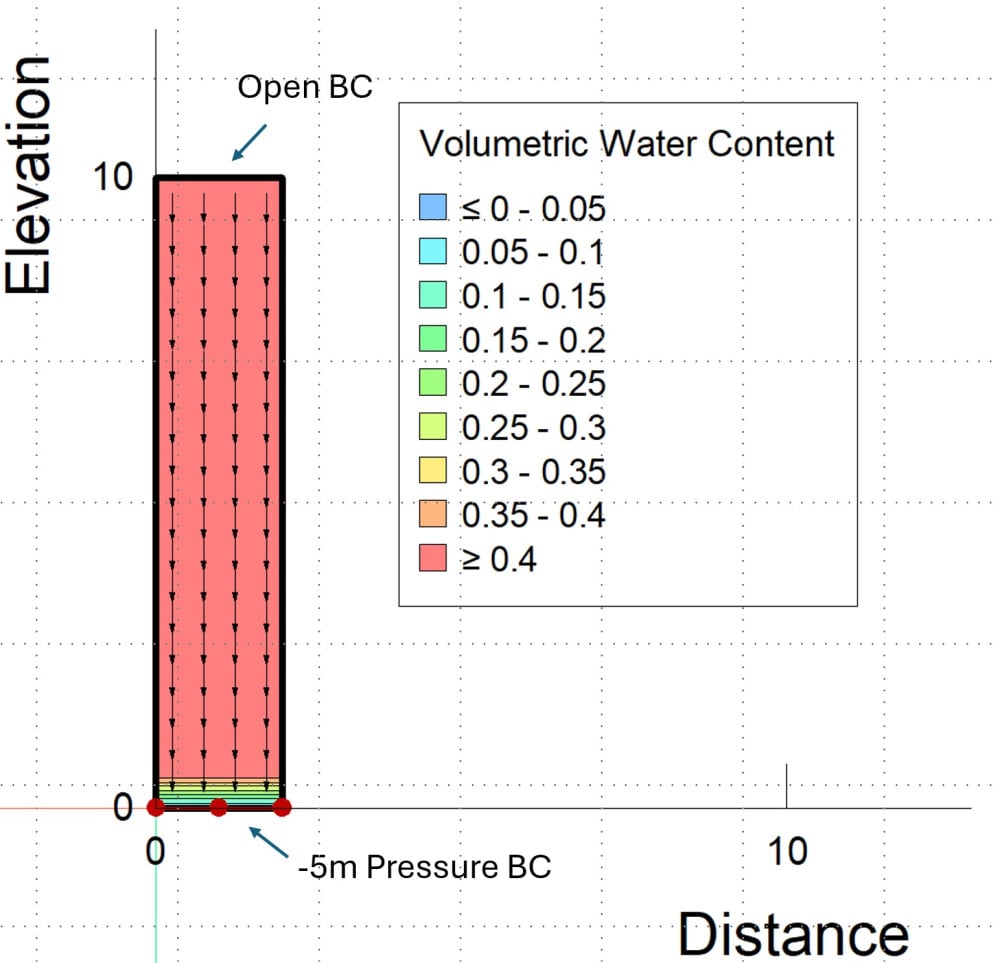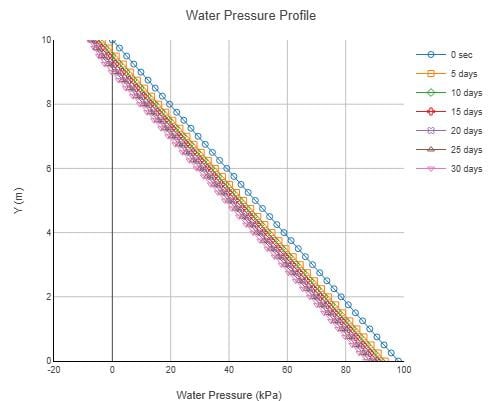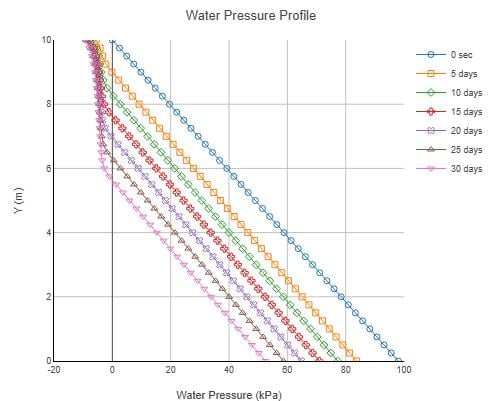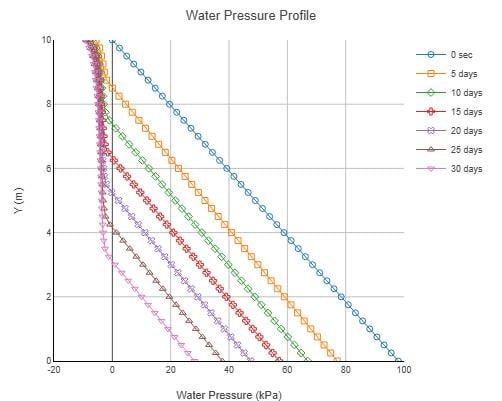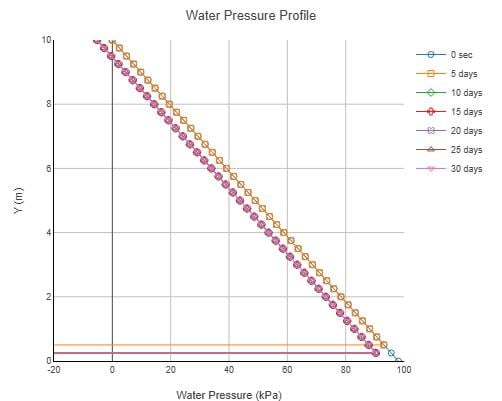Is it possible to model negative pressures in SEEP/W
Hi All,
I'm working on a model where I need to actively extract water from the bottom of a 10m high sand column by applying suction. The goal is see how the the saturation changes over time.
I've applied a constant pressure head of -5m at the bottom to accelerate the dewatering process. I'm using the Saturated/Unsaturated Material model for sand.
The result is that at the boundary the pore water pressure becomes negative and desaturated (I assume because of the VWC function). As the boundary is on the bottom of 10m of saturated sand, there should be no air available to actually desaturate the soil. However SEEP/W does do this and as a result permeability of the sand close the the boundary reduces significantly. Which leads to an even lower flowrate then when I use a zero pressure BC at the bottom (which does not cause this desaturation effect).
How can I solve this issue, is the SEEP/W capable of handling negative pressures in this manner or is a negative pressure always coupled to a desaturation? Is there a workaround?
Possibly there is a different model I can use for this type of calculation?
Thanks,
Mark
Answers
-
Hey @AriannaMerli @ArjanJianfar @AliShokouhi @RobinBorgströmLohde do any of you know how Mark can work around this issue? Anything that's worked for you?
0 -
Hi Mark,
As you have correctly noted, applying suction to the bottom of the sand column results in unsaturated conditions when the applied suction exceeds the air-entry value of the sand. That said, it's important to emphasize that the vacuum experienced by the soil is not equal to the vacuum generated by the pump. The pump applies suction (i.e., negative pressure) to the water in the pipes, which induces upward water movement. This process also introduces head losses along the pipe due to friction and elevation changes, which reduces the effective pressure at the soil interface. The effective pressure at the soil boundary is a function of pipe capacity, head loss, and pipe length. You can either:
- Calculate the effective pressure using theoretical pipe flow equations, or
- Apply a flow rate boundary condition to model the system behavior more directly.
As shown below, smaller (less negative) outflow rates lead to small pressure changes, intermediate outflow rates lead to significant pressure changes, and larger flow rates lead to desaturation with negligible pressure changes. This behavior reflects the nonlinear relationship between suction and moisture content in unsaturated soils. It's also worth noting that the flow rates involved are quite small, given that water is being extracted from a relatively limited volume (a square-based hexahedron measuring one meter wide, one meter thick, and ten meters high.
Case 1
System Flow Rate = -1e-7 m³/s
Case 2
System Flow Rate = -5e-7 m³/s
Case 3
System Flow Rate = -7.5e-7 m³/s
Case 4
System Flow Rate = -1e-6 m³/s
0 -
Thanks for your extensive reply, and confirming that the desaturation is a consequence of the underpressure even though there is no actual access to air. I have found a partial workaround for this problem by using AIR/W to provide an overpressure of air at the top boundary and ambient conditions at the lower boundary. Herby maintaining the required pressure difference and allowing air to enter the system at the top. Works for this specific case.
However my actual problem is a bit more complicated than the simplified case I put in my opening post, the soil is not homogenous but consists of various layers. I found that a low permeable layer halfway the column and a high permeable layer at the bottom combined with a zero pressure water BC at the bottom also gives this desaturation issue. The "hanging water" in the lower high permeable layer creates an underpressure at the interface with the low permeable layer, resulting in a desaturation even though the column of soil above the low permeable layer is still fully saturated.
So even with the AIR/W workaround I'm not convinced that draining a pile layered soil at the bottom will provide correct results.
Kind regards,
Mark
0 -
Hi Mark,
To provide a comprehensive answer, please send us your file and details to our support portal at the link below. Please include the details on what you are trying to model and any relevant context/information.
Thanks,
Kathryn0 -
Hi Kathryn,
I'm having some trouble signing in into the support section, not sure why that is.
Is there another way to share my files with you?Below a short simple sketch of the underpressure/desaturation issue I see with a layered structure.
I've defined a 5 m column filled with sand (using sample function, k=1e-4). And a clay layer from 3.5 to 4 m (using sample function, k=1e-9). The top boundary a 1m pressure head and at the bottom a zero pressure.
I would expect and underpressure in the lower sand layer, but it to remain fully saturated as the underpressure is too low for cavitation and there is no access to air. Basically no outflow of water though the bottom BC.Running it for the duration of a day results in the right image, the bottom sand layer under the clay layer is partly desaturated. The clay layer itself and the sand on top of it is fully saturated as is the sand close to the bottom BC. So also here air seems to be generated while there is no access to it in practice.
Kind regards,
Mark
0 -
Hi Mark,
What organization do you work for? If your organization has an Enterprise agreement with Bentley, you can submit a support ticket here:
CSM Service Catalog - Customer Service
Thanks,
Kathryn0 -
Hi Kathryn,
It took a while, but my license is operational again and send the example to customer support.
Thanks,
Mark
0
